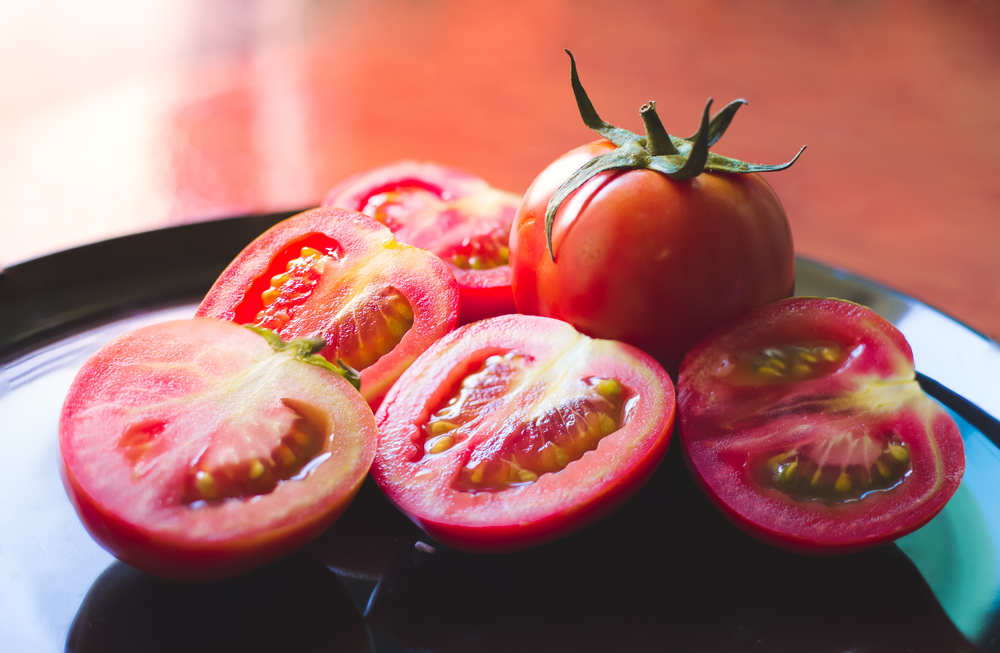Scientists Engineer Tomato That Could Be Low-cost Source of Levodopa
Written by |

Scientists have created a tomato enriched in levodopa, or L-DOPA, a standard therapy for people with Parkinson’s disease.
These tomatoes could represent a scalable, low-cost alternative L-DOPA source for Parkinson’s patients, particularly those in developing nations where treatment cost is prohibitive.
Additional benefits of the engineered tomatoes include higher levels of amino acids, antioxidants, a longer shelf life, and more fungal resistance than regular tomatoes.
“The idea is that you can grow tomatoes with relatively little infrastructure,” study author Cathie Martin, PhD, said in a press release. “As GMOs (genetically modified organisms), you could grow them in screen houses, controlled environments with very narrow meshes, so you would not have pollen escape through insects.”
“Then you could scale up at relatively low cost. A local industry could prepare L-DOPA from tomatoes because it’s soluble, and you can do extractions. Then you could make a purified product relatively low tech which could be dispensed locally,” she added.
Findings were detailed in the study, “Metabolic engineering of tomato fruit enriched in L-DOPA,” published in the journal Metabolic Engineering.
L-DOPA is the gold standard in Parkinson’s treatment. Upon entering the brain, it is converted into dopamine — a neurotransmitter, or chemical messenger, that is gradually lost in people with the condition.
The most common source of L-DOPA is chemical synthesis. But there are biological sources as well, mainly in plant seeds, where L-DOPA is thought to be useful as a defensive repellent against predators and other invasive plants.
However, there are some issues with extracting L-DOPA directly from plants or seeds, including the presence of other toxic compounds; thus, generating large amounts of L-DOPA in safer plant species may be a feasible alternative to chemical synthesis.
Furthermore, as the incidence of Parkinson’s is increasing in developing nations, where many cannot afford synthetic L-DOPA, a less expensive source would be beneficial.
The tomato is a widely cultivated crop with a well-characterized genome and metabolism. As a source of L-DOPA, tomatoes have the advantage of high levels of ascorbate — or vitamin C — which would prevent the oxidation of L-DOPA.
Based on this, researchers at the John Innes Centre in the U.K. developed a tomato plant that accumulated L-DOPA in the fleshy fruit, which can be scaled up for large-scale production, potentially providing a standardized natural source of L-DOPA.
In several plant species, L-DOPA is generated by enzymes (tyrosinases) from the amino acid tyrosine — a protein building block. Here, the team used a gene known as CYP76AD6 that provides instructions for making one of these enzymes in beetroot, a relative of sugar beets.
The CYP76AD6 gene was inserted into the tomato genome along with a segment of DNA that promoted high gene activity in the fruit of the tomato. Tests confirmed the accumulation of L-DOPA in these tomatoes up to 0.18% of total dry weight. Untreated tomatoes showed no accumulation.
Because L-DOPA is synthesized from tyrosine, which is necessary to the plant, metabolic tests were conducted to determine the impact of this gene insertion. Experiments found higher levels of other amino acids in the L-DOPA tomatoes. As expected, tyrosine levels were lower than in regular fruit, but this decrease was not statistically significant.
Next, the team cross-bred L-DOPA tomatoes with another tomato carrying a gene known as MYB12 from the arabidopsis plant, a cabbage relative that generates higher levels of the L-DOPA precursor tyrosine. Here, the average accumulation of L-DOPA was 0.27% of the dry weight, which was more than 30% higher than in uncrossed L-DOPA tomatoes.
The crossed L-DOPA fruit also had a higher antioxidant capacity than either of the parental lines alone, “confirming the positive association between L-DOPA levels and antioxidant capacity,” the researchers wrote.
To test whether the high antioxidant capacity affected shelf-life, the tomatoes were left for five weeks. Although the water loss rate was slightly faster in L-DOPA-accumulating fruit over regular tomatoes, fruit from control plants completed softening within a week. In contrast, L-DOPA tomatoes were firmer and softened between three to five weeks.
L-DOPA tomatoes were also more resistant to a parasitic fungal infection than regular fruit. They were also slightly darker and showed dark brownish spots on their surface, which was confirmed as melanin. This L-DOPA breakdown product was lower in intact fruit but occurred rapidly upon air exposure.
The researchers estimated the levels of L-DOPA produced was 150 mg per kg of tomatoes.
“The L-DOPA levels achieved in tomato fruit were comparable to the levels in other non-seed organs of L-DOPA – accumulating plants,” the researchers wrote.
“We have demonstrated that the use of the tyrosinase-expressing tomatoes as a source of L-DOPA is possible. It’s a further demonstration of tomato as a strong option for synthetic biology. Additionally, there were surprising beneficial effects, including improvement in shelf-life and raised levels of amino-acids that we can investigate,” said Dario Breitel, PhD, the study’s first author.





